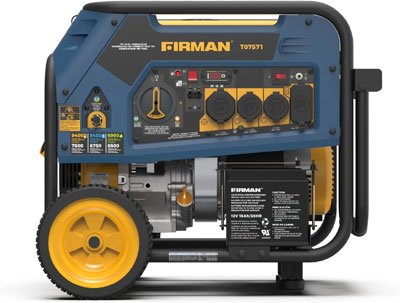To keep a generator battery charged, regularly run the generator and use a trickle charger. Maintaining a generator battery ensures readiness and reliability.
Generators are indispensable tools for providing power during outages or in areas without access to the electrical grid. A well-maintained generator can be a lifeline during emergencies, powering essential appliances and tools. The heart of this reliability often lies in the generator’s battery, which requires regular attention to stay charged and ready for use.
Ensuring the battery is properly charged not only extends its life but also guarantees that your generator starts quickly when needed. This guide offers straightforward tips to keep your generator’s battery in top condition, ensuring it’s always ready to deliver power when you need it most.
Introduction To Generator Battery Maintenance
Maintaining a generator battery is key for reliable power. A well-charged battery ensures smooth starts. Regular maintenance extends battery life. Let’s explore the importance of keeping your generator battery charged.
Importance Of A Charged Battery
A charged battery is essential for generator readiness. It powers the starter motor. It also runs electronic components when the generator is off. Keeping the battery charged avoids power interruptions.
Consequences Of Neglect
Neglecting battery maintenance leads to failures. A dead battery can’t start the generator. This results in unexpected downtime. Regular checks prevent such issues.

Credit: m.youtube.com
Selecting The Right Battery For Your Generator
Generators ensure power when you need it most. But they can’t work without a good battery. Choosing the right battery is crucial for generator reliability. Read on to learn about the different types and what to consider for capacity and compatibility.
Battery Types
Generators use different batteries. The most common are lead-acid and lithium-ion. Lead-acid batteries are affordable and widely available. They come in two types: maintenance-free and those needing regular water top-ups. Lithium-ion batteries are lighter and last longer. They charge faster and work well in cold weather.
Capacity And Compatibility
Capacity matters for generator batteries. It’s measured in ampere-hours (Ah). Higher capacity means longer run times. Make sure the battery voltage matches your generator. Check the generator manual for recommendations.
- Match battery size to generator compartment.
- Consider run time needs. Pick higher Ah for longer use.
- Ensure proper fit and secure placement.
| Battery Type | Pros | Cons |
|---|---|---|
| Lead-Acid | Cheaper, easy to find | Heavier, needs maintenance |
| Lithium-Ion | Lightweight, longer life | More expensive, less common |
Selecting the right generator battery is simple. Focus on type, capacity, and compatibility. Your generator will be ready to go when you need it.
Fundamentals Of Battery Charging
Fundamentals of Battery Charging are crucial to maintain your generator’s battery life. Proper battery charging ensures readiness and longevity. Learn the right ways to charge a generator battery here.
Charging Process
The charging process is simple yet vital. It involves replenishing the battery’s stored energy. Follow these steps for an effective charge:
- Turn off the generator.
- Connect the charger to the battery terminals.
- Set the correct voltage on the charger.
- Monitor until fully charged, then disconnect.
Voltage And Current Basics
Understanding voltage and current is key. Voltage pushes electrical energy into the battery. Current is the flow of this energy. Check these to prevent overcharging:
| Battery Type | Recommended Voltage | Current |
|---|---|---|
| Lead-Acid | 12.6-14.4V | 10A |
| Lithium-Ion | 12.8-14.6V | 5A |
Always refer to the battery’s manual for exact figures. Use a multimeter to measure voltage and current.

Credit: www.reddit.com
Regular Charging Techniques
Maintaining your generator’s battery charged is key. Regular Charging Techniques ensure it’s always ready. Let’s explore two popular methods: Trickle Charging and Float Charging.
Trickle Charging
Trickle Charging keeps batteries full over time. It adds power slowly. This method suits stored generators. It prevents overcharging. A trickle charger is small and easy to use. Follow these steps:
- Connect the charger to the battery.
- Plug the charger into a power outlet.
- Let it charge until full.
- Unplug and store the charger.
Remember, check the battery level monthly.
Float Charging
Float Charging is another safe way to keep batteries ready. It supplies power at the same rate the battery loses it. This keeps the battery at 100% without damage. Perfect for emergency generators. Here’s how to do it:
- Connect the float charger to your battery.
- Turn on the charger.
- The charger adjusts as needed.
This method requires a smart charger. It stops charging automatically when full.
Advanced Charging Systems
Advanced Charging Systems ensure your generator battery stays charged. These systems use modern technology to keep batteries ready. Let’s explore two popular options.
Smart Chargers
Smart Chargers are intelligent devices. They adjust charging based on the battery’s needs. This prevents overcharging and extends battery life. Key features include:
- Automatic adjustment to battery status
- Built-in safety features to prevent damage
- Easy to use and set up
Using a Smart Charger keeps your generator’s battery in top shape. It charges the battery only when needed. This saves energy and money.
Solar Charging Options
Solar Charging Options use sunlight to charge batteries. They are eco-friendly and cost-effective. Benefits include:
- Use of free solar energy
- Low maintenance needs
- Environmentally friendly choice
Solar panels convert sunlight into electricity. This electricity charges the generator’s battery. It’s a smart choice for those looking for green solutions.
Monitoring Battery Health
Keeping your generator’s battery charged is crucial. A healthy battery ensures your generator starts when needed. Regular monitoring extends battery life. Let’s explore ways to maintain battery health.
Voltage Checks
Voltage checks are a quick health indicator. Use a voltmeter to measure battery voltage. A fully charged battery typically shows around 12.6 volts. Readings under 12.4 volts suggest a charge is necessary.
Load Testing
A load test measures battery performance. It simulates a start-up load. The test ensures the battery can handle the generator’s needs. Perform load tests regularly. A failing test indicates it’s time for a recharge or replacement.
| Battery Check | Action |
|---|---|
| Voltage Reading | Check and Charge |
| Load Test | Test and Evaluate |
Remember, battery maintenance is key. Perform voltage checks and load tests regularly. Keep your generator ready for any emergency.
Maintenance Tips To Prolong Battery Life
Maintenance Tips to Prolong Battery Life ensure your generator is always ready. Regular upkeep can prevent power loss. Follow these simple steps to keep your generator battery charged and efficient.
Cleaning Connections
Clean battery connections stop power issues. Dirt and corrosion block electricity. Use a wire brush for cleaning. Disconnect terminals before starting. Clean both posts and clamps. Reconnect tightly after drying.
Ensuring Proper Electrolyte Levels
Check electrolyte levels for optimal performance. Low levels cause weak batteries. Use distilled water for refilling. Never overfill the cells. Wear protective gear for safety. Check levels every two months.
Troubleshooting Common Battery Issues
Generators are crucial for reliable power. Yet, battery issues can cause headaches. Knowing how to troubleshoot these issues is key. Let’s dive into some common problems and fixes.
Sulfation
Sulfation occurs when a battery sits without charge for too long. This leads to hard sulfate crystals forming on the battery plates. These crystals can prevent the battery from holding a charge. To fix this:
- Use a desulfation device to break down crystals.
- Charge the battery at a low rate for a longer time.
- Regularly maintain charge levels to prevent recurrence.
Acid Stratification
Acid stratification happens when the acid in the battery separates from the water and sinks to the bottom. This can reduce battery performance. To address this issue:
- Charge the battery fully to mix the acid and water.
- Avoid short charging cycles that don’t fully charge the battery.
- Periodically use an equalization charge if the manufacturer allows it.
Safe Handling And Disposal
Maintaining your generator battery is crucial for reliability. Proper care ensures it stays charged and ready for use. But what happens when it’s time to replace it? Disposing of a generator battery requires attention to safety and the environment. This section details the steps for safe handling and disposal of generator batteries.
Safety Precautions
Generator batteries contain harmful chemicals. They can cause injury or pollution if mishandled. Always wear gloves and eye protection when working with batteries. Ensure the area is well-ventilated. Keep children and pets away from the work area.
- Avoid open flames or sparks near batteries.
- Do not short-circuit the battery terminals.
- Use proper tools to prevent accidental contact.
Recycling Old Batteries
When a generator battery reaches its end of life, recycle it. This prevents harmful materials from entering the environment. Many stores that sell batteries also offer recycling services. Contact local waste management for battery disposal guidelines.
| Step | Action |
|---|---|
| 1 | Remove battery from generator |
| 2 | Place in a sturdy container |
| 3 | Take to a recycling center |
Never throw batteries in the trash. Lead, acid, and other materials can harm the environment. Your actions make a difference. Be responsible and recycle.
Legal And Environmental Considerations
Keeping your generator battery charged involves important legal and environmental aspects. It’s not just about ensuring a reliable power source. It’s also about following laws and protecting the environment. Here’s what you need to know:
Compliance With Regulations
Generators, including their batteries, must meet specific regulations. These may vary by country or region. Always check local laws to avoid fines and ensure safety.
- Permits: Some areas require permits for generator use.
- Safety Standards: Batteries must meet safety standards to prevent accidents.
- Disposal Rules: Follow proper disposal methods for old batteries.
Eco-friendly Practices
Adopting eco-friendly practices benefits everyone. Here’s how to keep your generator battery charged while being green:
- Use Solar Chargers: They harness natural energy and reduce emissions.
- Recycle Batteries: Proper recycling prevents harmful chemicals from damaging the environment.
- Maintenance: Regular checks ensure efficient battery use and longer life.

Credit: www.batteryequivalents.com
Frequently Asked Questions
Why Is Maintaining Generator Battery Charge Important?
Maintaining a generator battery charge ensures reliable starts, prolongs battery life, and prevents power outages from affecting your readiness.
How Often Should I Charge My Generator Battery?
Charge your generator battery according to the manufacturer’s guidelines, typically every 30 days, to maintain optimal performance.
Can Trickle Chargers Keep Generator Batteries Charged?
Trickle chargers are an effective way to keep generator batteries charged by providing a constant, low-level current to the battery.
What Affects A Generator Battery’s Charge Level?
A generator battery’s charge level can be affected by temperature extremes, long periods of inactivity, and the natural self-discharge of the battery.
How Do I Know If My Generator Battery Is Fully Charged?
Check your generator battery’s charge level with a voltmeter or a built-in charge indicator, if available, to ensure it’s fully charged.
Conclusion
Maintaining a charged generator battery ensures readiness during power outages. Regular checks, smart chargers, and proper storage are key. By following these practices, your generator will be primed for action, providing peace of mind and reliability when you need it most.
Stay powered, stay prepared.




